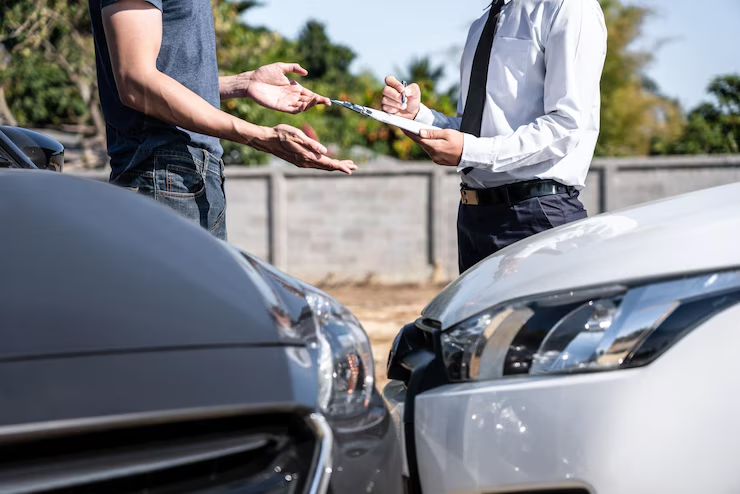Introduction
A car accident can be a frightening and overwhelming experience. Whether it’s a minor fender-bender or a more serious collision, knowing what to do next is crucial—especially when it comes to handling the insurance process. Acting quickly and correctly can make a significant difference in how smoothly your claim is processed and how well you’re protected financially.This guide walks you through exactly what steps to take after a car accident, including how to file an insurance claim, what information to gather, and how to protect your rights.

Table of Contents
Stay Calm and Check for Injuries
Move to Safety
Call Emergency Services
Document the Scene
Exchange Information
Notify Your Insurance Company
Understand the Claims Process
What Not to Do After an Accident
Frequently Asked Questions
Final Thoughts
Stay Calm and Check for Injuries
Immediately after an accident:
Take a deep breath and stay calm.
Check yourself and passengers for injuries.
If anyone is hurt, call 911 right away.
Even if injuries seem minor, it’s best to seek medical attention—some symptoms (like whiplash) may appear hours later.
Move to Safety
If the vehicles are drivable:
Turn on hazard lights.
Move your car to the side of the road or a safe area nearby.
If the car can’t be moved or if it’s unsafe, stay inside with your seatbelt fastened until help arrives.
Call Emergency Services
Even in a minor accident, it’s often wise to call the police:
A police report provides an official record.
It may be required by your insurance company.
Officers can help mediate the situation if needed.
In some states, calling the police is legally required if damages exceed a certain amount or if there are injuries.
Document the Scene
Thorough documentation can make or break your claim. Use your smartphone to capture:
Photos of all vehicles involved, including license plates
Damage to cars, guardrails, signs, or other property
Road conditions, traffic signals, and skid marks
Close-ups and wide shots of the scene
Also, write down:
Time and date of the accident
Location
Weather and visibility conditions
Exchange Information
Politely exchange the following with the other driver(s):
Full name
Phone number
Address
Driver’s license number
License plate number
Insurance company and policy number
Vehicle make, model, and color
Important: Don’t admit fault or blame the other driver. Let the insurance companies and police determine liability.
Notify Your Insurance Company
Report the accident to your insurer as soon as possible—ideally within 24 hours.
Be ready to provide:
Your policy number
Date, time, and location of the accident
A brief description of what happened
Names and contact info of others involved
Police report number (if available)
Photos and documentation
Most insurers allow you to start a claim through:
Mobile apps
Online portals
Phone calls to claims representatives
Understand the Claims Process
Here’s what typically happens next:
Claim Assignment
An adjuster is assigned to investigate your claim.
Damage Evaluation
They may inspect your vehicle, or ask you to visit an approved repair shop.
Estimate & Settlement
You’ll receive an estimate for repairs and a settlement offer. If you have comprehensive or collision coverage, your policy may cover repair or replacement costs (minus your deductible).
Repairs
You choose a repair shop (some insurers offer a network of preferred shops).
Rental Car
If you have rental reimbursement coverage, the insurer will cover rental costs during repairs.
What Not to Do After an Accident
Avoid these common mistakes:
Don’t flee the scene. It’s illegal and makes things worse.
Don’t admit fault. Even saying “I’m sorry” can be used against you later.
Don’t skip medical evaluation. Minor injuries can become serious.
Don’t delay notifying your insurer. Late reports may complicate your claim.
Frequently Asked Questions
Do I need a police report to file a claim?
Not always, but it’s highly recommended. Some states or insurers may require one, especially in major accidents.
Should I file a claim if the damage is minor?
Even minor damage should be reported—some underlying damage may not be immediately visible.
Will my insurance rates go up?
Possibly. If you’re at fault, your premiums may rise. If you’re not at fault, your insurer may still review your risk profile, but some companies offer accident forgiveness.
What if the other driver is uninsured?
If you have uninsured motorist coverage, it can help cover damages or injuries caused by uninsured drivers.

Conclusion
Being in a car accident is stressful, but knowing exactly what steps to take can make a big difference. From ensuring everyone’s safety to navigating the insurance process, a calm and informed approach helps protect your rights, finances, and well-being.Prepare yourself in advance by keeping:Your insurance card.Emergency contact list.A phone chargerA notebook and pen in your glove box.Because when the unexpected happens, being prepared is the best protection of all.Learn exactly what to do after a car accident with this clear guide on the essential insurance steps. From gathering evidence at the scene to filing your claim, we explain each step to ensure you’re protected and prepared.

